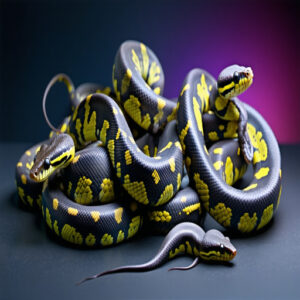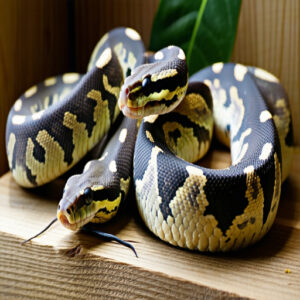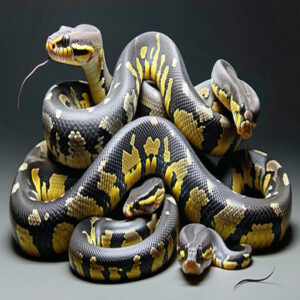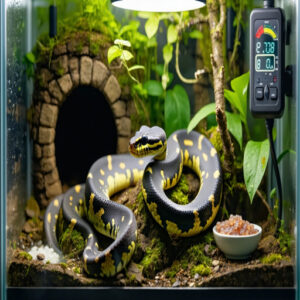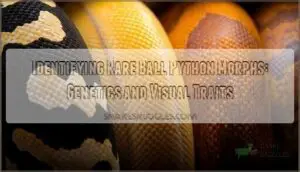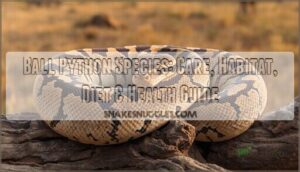This site is supported by our readers. We may earn a commission, at no cost to you, if you purchase through links.
 Breeding ball python morphs is like painting with genetics—every pairing can create a masterpiece of color and pattern.
Breeding ball python morphs is like painting with genetics—every pairing can create a masterpiece of color and pattern.
These morphs stem from genetic mutations that affect pigmentation and pattern expression, with over 4,000 possible combinations out there.
To breed successfully, you’ll need healthy, mature pythons and precise control of temperature (88–92°F) and humidity (60–80%).
By pairing dominant and recessive traits, you can discover dazzling morphs like Albino or Blue Eye Leucistic.
It’s a mix of science and strategy, and patience is key. Ready to create a python that’s the talk of the reptile world? Genetic surprises await!
Table Of Contents
- Key Takeaways
- Ball Python Morph Basics
- Breeding Ball Pythons
- Ball Python Genetics
- Hatchling Care and Setup
- Advanced Breeding Techniques
- Frequently Asked Questions (FAQs)
- What is the rarest morph of ball python?
- Can I breed my ball python?
- Can you breed different types of pythons?
- What morphs make a bumblebee ball python?
- Can you breed different morphs of ball pythons?
- What is the most sought after ball python morph?
- Can you cross breed ball pythons?
- How do I handle a gravid ball python?
- What is the impact of feeding live prey?
- Are there health risks in inbreeding morphs?
- Conclusion
Key Takeaways
- Understand ball python genetics by mastering dominant, recessive, and co-dominant traits to create unique morphs with stunning colors and patterns.
- Ensure breeding success by maintaining proper temperature (88-92°F) and humidity (60-80%), and selecting healthy, mature snakes—females over 1,500 grams and males over 700 grams.
- Avoid inbreeding to prevent health risks like genetic deformities or neurological issues; prioritize genetic diversity for healthy offspring.
- Experiment with strategic pairings like Banana + Pied or Lesser + Mojave to produce rare morphs like Blue Eyed Leucistics or Bumblebees.
- The instructions provided are crucial for the successful breeding of ball pythons, ensuring both the health and uniqueness of the offspring.
Ball Python Morph Basics
Ball python morphs are fascinating genetic variations that give these snakes their stunning colors and intricate patterns.
By understanding how traits like recessive and dominant genes work, you can breed unique combinations and create incredible visual appearances.
Color Morphs and Patterns
Within the fascinating world of ball python morphs, you’ll discover over 4,000 unique combinations of colors and patterns.
Each morph’s scale variations create nature’s living artwork, from the elegant pinstripe‘s suit-like pattern to the dark beauty of black pastel morphs.
These morphs range in price and availability, as detailed on a ball python morph resource.
Pattern recognition reveals distinct features like alien heads and heart shapes, while color morphs showcase everything from rich cinnamon browns to striking albino whites.
Genetic Basis of Morphs
Recent scientific discoveries have revolutionized our understanding of ball python genetics, with researchers identifying specific genes like TYRP1 that control color variations.
These genetic mutations orchestrate your snake’s unique appearance like a master painter with DNA as their brush.
Further genetic details are available on this informative page about ball python morph genetics.
Ball python morphs emerge from intricate genetic traits affecting pigmentation and pattern expression.
- Albino, Lavender Albino, and Ultramel morphs all show distinct melanin variations in skin and eyes
- Scientists work with hobby breeders to decode the genetic basis of distinctive color patterns
- The Clown morph offers key insights into snake skin pigmentation and patterning
Inheritance Patterns and Traits
Working with ball python morph genetics is like solving a puzzle – each genetic code piece fits together in specific ways.
You’ll spot dominant genes showing up right away in your snake’s appearance, while recessive traits need two copies to shine through.
Trait expression follows clear patterns: some morphs mask others, while certain combinations create stunning results through genetic inheritance.
Breeding Ball Pythons
You’ll find that breeding ball python morphs combines science and art as you match compatible pairs to create stunning color variations and patterns.
When you’re ready to start your breeding journey, you’ll need a mature female (at least 1,500 grams) and a healthy male, plus the right setup to control temperature and humidity for successful breeding.
Preparing for Breeding Season
Late August marks the start of your ball python breeding season preparation.
You’ll need to begin temperature cycling, gradually dropping nighttime temperatures to 70-75°F to mirror their natural breeding patterns. Maintaining precise seasonal care through winter cooling helps trigger their breeding instincts.
Understanding proper ball python breeding is essential for a successful breeding season.
- Feel the excitement as your pythons respond to nature’s ancient rhythms – it’s like orchestrating a delicate dance
- Create your own slice of python paradise with perfect temperature gradients
- Watch in wonder as winter’s cooling magic awakens their breeding instincts
Male and Female Selection
Successful ball python breeding starts with smart genetic matching.
Your female needs to hit that 1,500-gram sweet spot and be at least three years old before joining the dating pool.
Males can be ready earlier – just make sure they’re over 700 grams.
When you’re picking morphs to pair, it’s like matchmaking for snakes: check their genetic profiles to avoid any unwanted neurological surprises in the offspring, which is crucial for successful ball python breeding and requires careful consideration of genetic profiles.
Temperature and Humidity Control
Getting your ball python’s climate control just right can make or break your breeding success.
You’ll need to nail these key factors for your snake’s comfort:
- Maintain temperature gradients between 88-92°F on the warm side and 78-80°F on the cool side
- Keep humidity levels steady at 60-80% during breeding season
- Use reliable heat sources like ceramic heaters plus proper ventilation systems
Note: daily misting helps hit those humidity sweet spots. Understanding the ideal ball python temperature humidity is essential for creating a suitable environment for your snakes.
Ball Python Genetics
You’ll find that ball python genetics works like a colorful puzzle, where dominant and recessive genes mix to create stunning morphs with unique patterns and colors.
Just as you’d inherit your parent’s traits, these fascinating reptiles pass down their genetic mutations to create endless possibilities, from simple albinos to complex designer morphs that’ll make your jaw drop.
Recessive and Dominant Traits
The magic behind ball python morphs lies in their genetic expression patterns.
Think of dominant genes as natural-born leaders—they’ll show up whenever they’re present, like the Spider trait commanding attention in every offspring.
Recessive mutations play hard to get—you’ll need two copies before seeing that gorgeous albino shine through.
But here’s where it gets fun: codominant genes create a perfect blend, like mixing paint colors in your snake-breeding palette.
Intermediate and Advanced Morphs
Snake genetics unfolds like a treasure map, with intermediate and advanced ball python morphs offering stunning pattern mutations and rare traits.
You’ll discover three distinct tiers of genetic complexity:
- Spider and Champagne morphs showcase intermediate pattern mutations
- Ghost and Yellow Belly morphs reveal advanced snake coloration patterns
- Advanced morphs like Mojave require precise genetic understanding.
Take care when breeding Spider-gene morphs—they can display a wobble condition.
Combining Morphs for Unique Results
Now that you’ve mastered advanced morphs, let’s play genetic matchmaker.
Pattern mixing in ball python breeding is like cooking up your dream snake. You’ll combine different morph combinations to create stunning hybrid results.
Understanding genetic variations is essential for predicting the outcomes of these combinations.
Here’s your cheat sheet for popular pairings:
| Parent Morphs | Genetic Outcomes | Color Variations |
|---|---|---|
| Banana + Pied | High-contrast patches | Yellow-white mix |
| Mojave + Lesser | Blue Eyed Leucistic | Pure white beauty |
| Pastel + Spider | Bumblebee morph | Golden stripes |
| Clown + Pinstripe | Designer patterns | Enhanced blushing |
Hatchling Care and Setup
You’ll need to set up a cozy starter home for your ball python hatchlings with proper temperature zones and a simple hide box.
With your careful attention to maintaining steady warmth and humidity levels, you’ll help your little Python regius thrive in their new environment.
Enclosure Design and Temperature
Now that you understand morph genetics, let’s design your hatchling’s first home.
Your ball python habitat needs a cozy 10-20 gallon snake enclosure to start. Create temperature gradients with proper heat sources: 88-92°F on the warm side and 76-80°F on the cool side.
Proper temperature control methods are essential for maintaining a healthy environment.
- Picture your tiny friend exploring their perfectly-sized space, feeling secure and protected
- Watch them bask confidently under their heat lamp, living their best snake life
- See them choose their favorite snug hide box, making it their personal retreat
- Notice how ventilation systems keep their environment fresh and comfortable
Feeding and Humidity Management
Feeding schedules are simple—offer hopper mice weekly for hatchlings.
Stick to quality-prey for proper snake nutrition.
Humidity levels? Aim for 60%-70%.
Too dry, and shedding gets tricky; too humid, bacteria parties.
Change water daily to maintain superior water quality.
Smart environmental control is key to ball python care—your snake’s habitat should feel like a cozy reptile resort.
For optimal health, understanding Ball Python Food options is crucial in planning a balanced diet.
Health Monitoring and Veterinary Care
Keeping hatchlings healthy isn’t just a “set it and forget it” deal.
Watch for signs of stress, poor appetite, or strange behavior—it could mean snake diseases like respiratory infections or parasites.
Schedule veterinary checks for ball python health, including health diagnostics for hidden genetic health issues.
Emergency care isn’t optional; quick action saves lives.
Proper snake care guarantees thriving, lively hatchlings!
Regular reptile veterinary checkups are vital for maintaining their overall well-being.
Advanced Breeding Techniques
You’ve mastered the basics, but now it’s time to take your ball python breeding skills to the next level.
With advanced techniques, you can access rare morph combinations and refine traits for truly stunning results.
Creating Rare Morphs and Combinations
Hatchlings grow fast, but let’s talk Morph Creation.
By pairing recessive and dominant traits strategically, you reveal stunning ball python color morphs through Genetic Mixing.
Pattern Hybridization with diverse genetics prevents hiccups like inbreeding.
Successful ball python breeding isn’t luck—it’s about patience, planning, and creating snakes that truly wow collectors, like those with rare combinations such as Dreamscicle or Sunset.
Mojave and Blue Eye Leucistic Morphs
Mojave ball pythons are a favorite for breeders tackling Blue Eyed Leucistic Morphs.
Pairing Mojave genetics with Lesser Platinum or Butter morphs often sparks those stunning white snakes with hypnotic blue eyes.
Morph genetics here spotlight eye color and leucistic traits, while proper care and breeding tips guarantee healthy outcomes.
These ball python morphs truly highlight the magic of snake patterns!
Breeding for Specific Color and Pattern Traits
Want stunning ball python morphs? Nail breeding techniques that maximize color genetics and pattern inheritance. Success comes down to smart trait selection and morph expression.
Here’s how to mix genetic diversity with creative ideas:
- Pair morphs with bold contrast or unique pattern combos.
- Aim for enhanced blushing or clean bellies.
- Track bloodlines closely.
- Experiment with subtle genetic variations.
Understanding ball python breeding is essential for achieving the desired morphs and traits in your ball python breeding program, by applying smart trait selection.
Frequently Asked Questions (FAQs)
What is the rarest morph of ball python?
Funny how some ball python morphs feel like finding a unicorn, isn’t it?
The rarest is perhaps the Stormtrooper morph—a genetic anomaly with stark black-and-white patterns, its origin still puzzles breeders and enthusiasts alike.
Can I breed my ball python?
You absolutely can, but first, verify your ball python pair is healthy and at the right breeding weight—females around 1,500 grams and males 700 grams.
Timing, temperature, and genetics all play huge roles!
Can you breed different types of pythons?
You can’t successfully breed different python species, like a ball python and a Burmese python.
This is because genetic differences make crossbreeding impossible, even though both are pythons.
Stick to breeding within the same species for results!
What morphs make a bumblebee ball python?
To create a Bumblebee ball python, you combine the Spider morph and the Pastel morph.
This pairing results in snakes with vibrant yellow patterns and a bold black web-like design—absolutely striking and unmistakable!
Can you breed different morphs of ball pythons?
Breeding ball python morphs is like painting with genetics—pairing specific traits creates one-of-a-kind patterns and colors.
You absolutely can mix morphs, but understanding recessive and dominant genes is essential for predictable, stunning offspring.
What is the most sought after ball python morph?
The Blue-Eyed Leucistic ball python tops the wishlist for many enthusiasts.
Its pure white body and striking blue eyes make it a showstopper.
Breeders chase this morph for its rarity and unparalleled elegance.
Can you cross breed ball pythons?
Think of genetics as a paint palette—you can absolutely crossbreed ball pythons to create hybrid morphs.
By combining recessive and dominant traits, you’ll discover stunning, one-of-a-kind colors and patterns in their offspring.
How do I handle a gravid ball python?
Handle your gravid ball python gently and avoid over-handling to reduce stress.
Provide a secure, warm hide, maintain ideal humidity (60-70%), and offer appropriately sized meals.
Give her space as she nears laying time.
What is the impact of feeding live prey?
Feeding live prey can trigger natural hunting instincts, but it risks injuries to your snake from bites or scratches.
Instead, pre-killed prey is safer, stress-free, and still satisfies their appetite—your fingers will thank you too!
Are there health risks in inbreeding morphs?
Playing genetic roulette with inbreeding can amplify issues like kinked spines, neurological problems, and weakened immune systems.
Without fresh genetic diversity, you’re risking morph deformities and a snake with health that’s anything but robust.
Conclusion
Breeding ball python morphs is like crafting a puzzle with endless colorful pieces—each pairing holds the potential for unique results.
By mastering genetics, maintaining proper care, and experimenting with traits, you’ll bring vibrant new patterns to life.
Whether you’re aiming for striking Albinos or the elegant Blue Eye Leucistics, patience and precision are everything.
Join the adventure, because with each egg, there’s the thrill of uncovering nature’s artistry.
Start small, dream big, and let the morphs amaze you!

